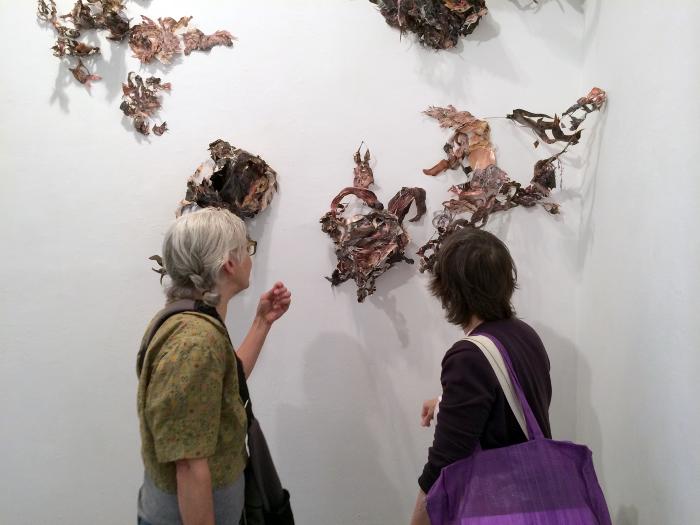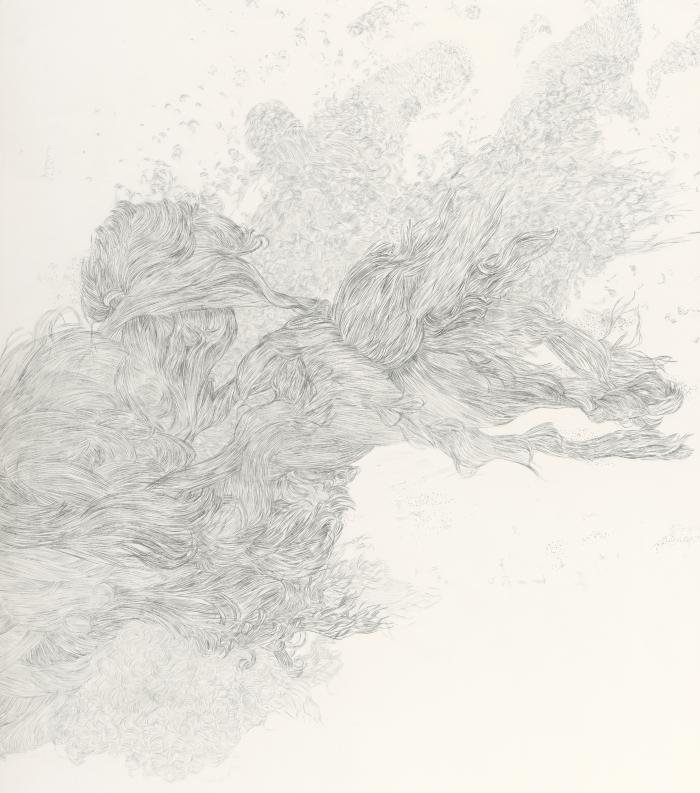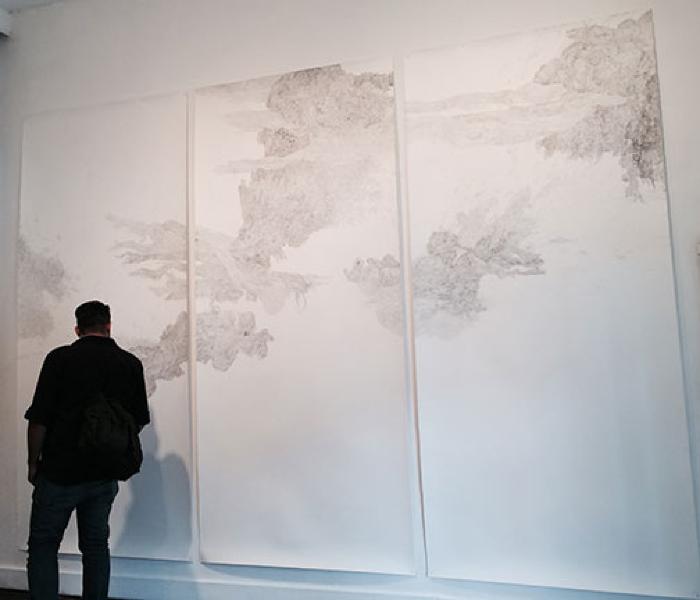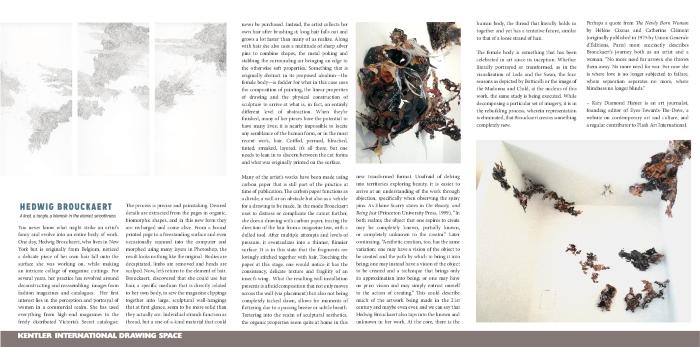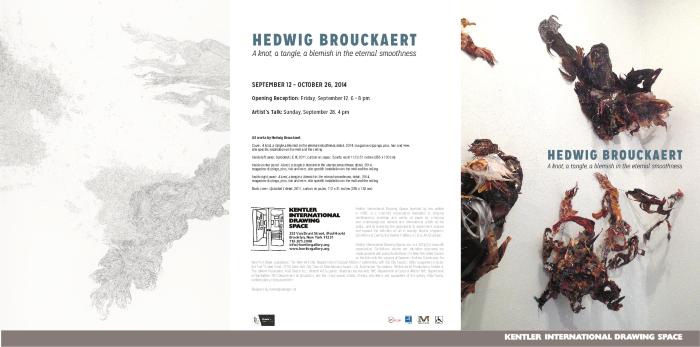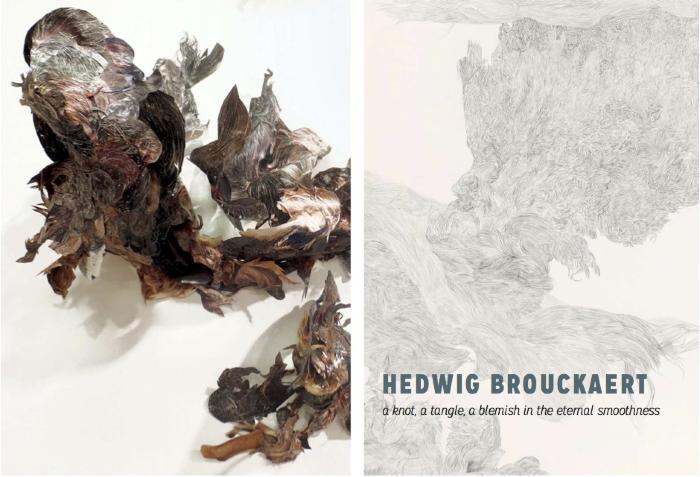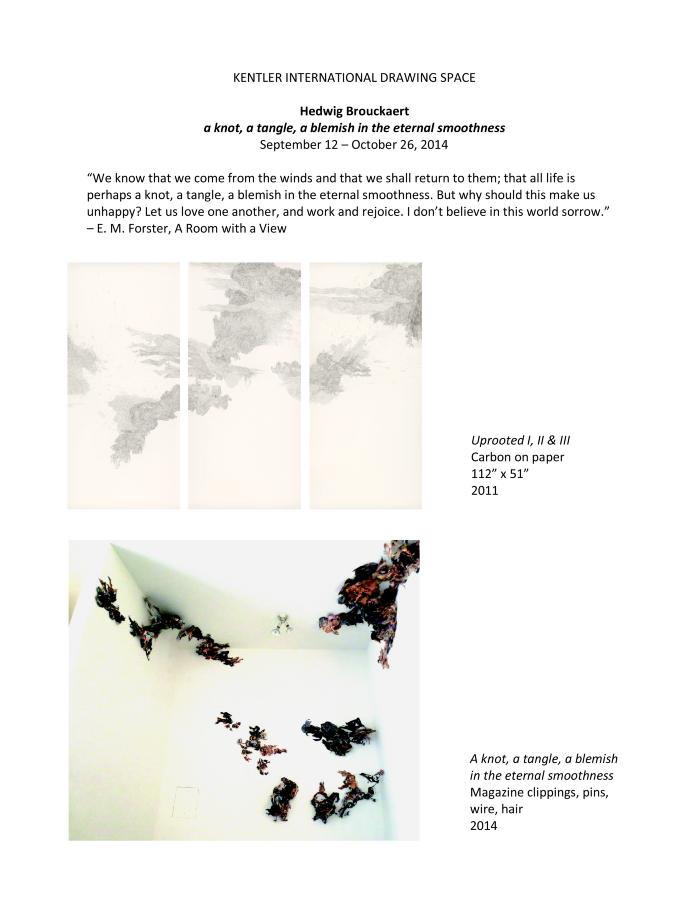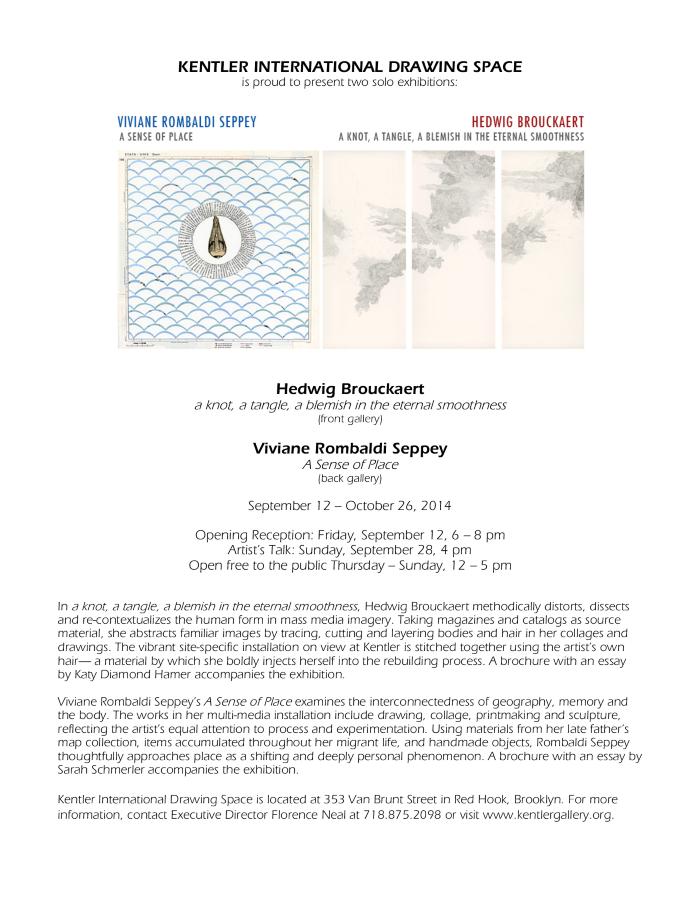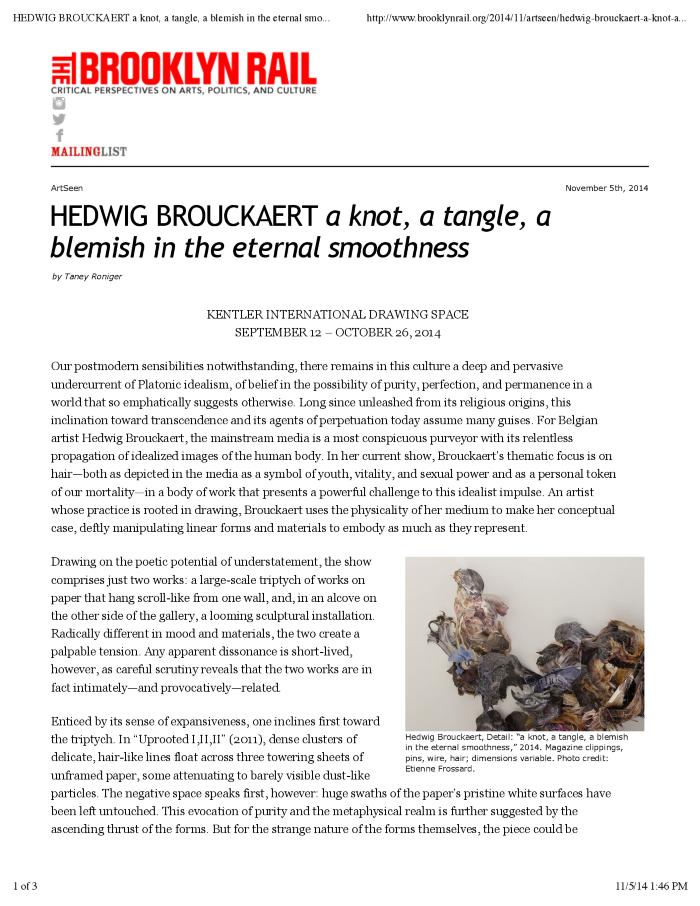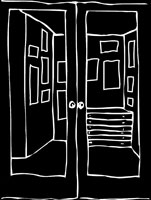exhibition
Hedwig Brouckaert
A knot, a tangle, a blemish in the eternal smoothness
Date
September 12 – October 26, 2014Opening Reception
September 12, 2014Artist
Hedwig Brouckaertexhibition Images
Click to Enlarge.
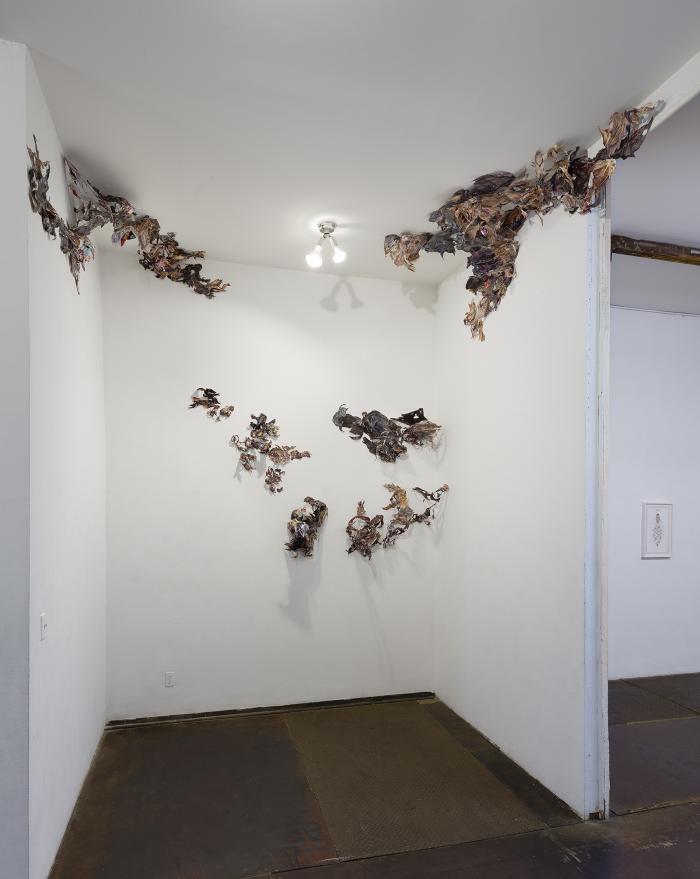
Hedwig Brouckaert, a Knot, a Tangle, a Blemish in the Eternal Smoothness, magazine clippings, pins, wire, hair, 2014 (photo credit: Etienne Frossard)
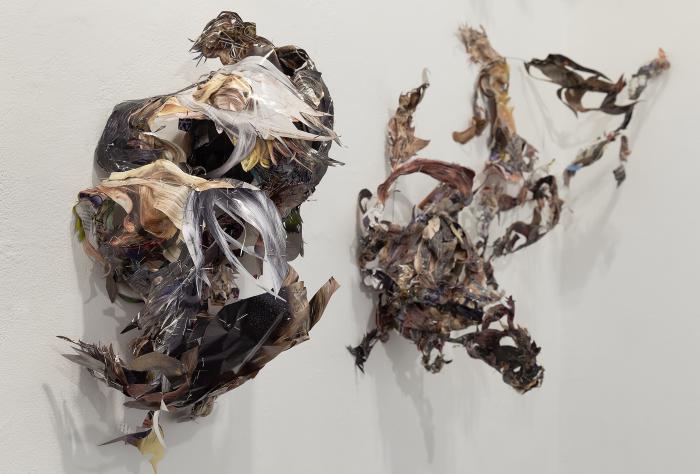
Hedwig Brouckaert, a Knot, a Tangle, a Blemish in the Eternal Smoothness, magazine clippings, pins, wire, hair, 2014 (detail) (photo credit: Etienne Frossard)
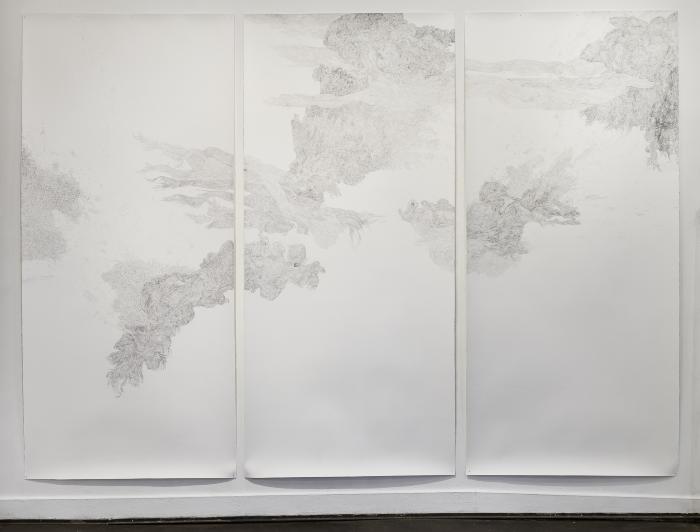
Hedwig Brouckaert, Uprooted I, II and III, carbon on paper, 112" x 51", 2011 (photo credit: Etienne Frossard)
Press and Promotion
About the exhibition
Hedwig Brouckaert
a knot, a tangle, a blemish in the eternal smoothness
Solo exhibition, front gallery space
Artist's Talk: September 28, 2014
We know that we come from the winds and that we shall return to them; that all life is a knot, a tangle, a blemish in the eternal smoothness. But why should this make us unhappy? Let us love one another, and work and rejoice. I don't believe in this world sorrow."
– E.M. Forster, A Room with a View
Hedwig Brouckaert
a knot, a tangle, a blemish in the eternal smoothness
You never know what might strike an artist’s fancy and evolve into an entire body of work. One day, Hedwig Brouckaert, who lives in New York but is originally from Belgium, noticed a delicate piece of her own hair fall onto the surface she was working on while making an intricate collage of magazine cuttings. For several years, her practice has revolved around deconstructing and reassembling images from fashion magazines and catalogues. Her first interest lies in the perception and portrayal of women in a commercial realm. She has used everything from high-end magazines to the freely distributed Victoria’s Secret catalogue. The process is precise and painstaking. Desired details are extracted from the pages in organic, biomorphic shapes and in this new form they are recharged and come alive. From a bound printed page to a freestanding surface and even occasionally scanned into the computer and morphed using many layers in Photoshop, the result looks nothing like the original. Bodies are decapitated, limbs are removed and heads are scalped. Now let’s return to the element of hair. Brouckaert, discovered that she could use her hair, a specific medium that is directly related to her own body, to sew the magazine clippings together into large, sculptural wall-hangings that at first glance seem to be more solid than they actually are. Individual strands function as thread, but a one-of-a-kind material that could never be purchased. Instead, the artist collects her own hair after brushing it; long hair falls out and grows a lot faster than many of us realize. Along with hair she also uses a multitude of sharp silver pins to combine shapes, the metal poking and stabbing the surrounding air bringing an edge to the otherwise soft properties. Something that is originally abstract in its proposed idealism—the female body—is fodder for what in this case uses the composition of painting, the linear properties of drawing and the physical construction of sculpture to arrive at what is in fact an entirely different level of abstraction. When they’re finished, many of her pieces have the potential to have many lives; it is nearly impossible to locate any semblance of the human form, or in the most recent work, hair. Coiffed, permed, bleached, tinted, streaked, layered, it’s all there, but one needs to lean in to discern between the cut forms and what was originally printed on the surface.
Many of the artist’s works have been made using carbon paper that is still part of the practice, at time of publication. The carbon paper functions as a divide, a wall or an obstacle but also as a vehicle for a drawing to be made. In the mode Brouckaert uses to distress or complicate the cutout further, she does a drawing with carbon paper, tracing the direction of the hair from a magazine tear, with a dulled tool. After multiple attempts and levels of pressure, it eventualizes into a thinner, flimsier surface. It is in this state, that the fragments are lovingly stitched together with hair. Touching the paper at this stage, one would notice it has the consistency, delicate texture and fragility of an insect’s wing. What the resulting wall installation presents is a fluid composition that not only moves across the wall (via placement) but also not being completely tacked down, allows for moments of fluttering due to a passing breeze or subtle breath. Teetering into the realm of sculptural aesthetics, the organic properties seem quite at home in this new transformed format. Unafraid of delving into territories exploring beauty, it is easier to arrive at an understanding of the work through abjection, specifically when observing the spiny pins. As Elaine Scarry states in On Beauty, and Being Just (Princeton University Press, 1999), “In both realms, the object that one aspires to create may be completely known, partially known, or completely unknown to the creator.” Later continuing, “Aesthetic creation, too, has the same variation: one may have a vision of the object to be created and the path by which to bring it into being; one may instead have a vision of the object to be created and a technique that brings only its approximation into being; or one may have no prior vision and may simply entrust oneself to the action of creating.” This could describe much of the artwork being made in the 21st century and maybe even ever, and we can say that Hedwig Brouckaert also taps into the known and unknown in her work. At the core, there is the human body, the thread that literally holds us together and yet has a tentative future, similar to that of a loose strand of hair.
The female body is something that has been celebrated in art since its inception. Whether literally portrayed or transformed as in the visualization of Leda and the Swan, the four seasons as depicted by Botticelli or the image of the Madonna and Child, at the nucleus of this work, the same study is being executed. While decomposing a particular set of imagery, it is in the rebuilding process, wherein representation is eliminated, that Brouckaert creates something completely new.
Perhaps a quote from The Newly Born Woman by Hélène Cixous and Catherine Clément (originally published in 1975 by Union Generale d’Éditions, Paris) most succinctly describes Brouckaert’s journey both as an artist and a woman. “No more need for arrows; she throws them away. No more need for war. For now she is where love is no longer subjected to failure, where separation separates no more, where blindness no longer blinds.”
–Katy Diamond Hamer is an art journalist, founding editor of Eyes-Towards-The-Dove, a website on contemporary art and culture, and a regular contributor to Flash Art International.
